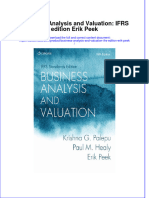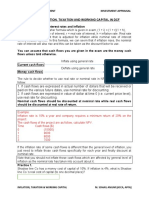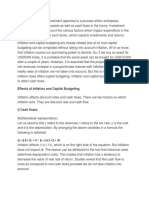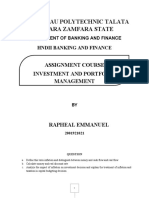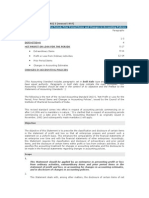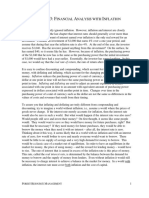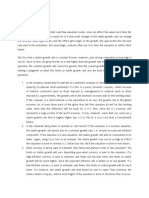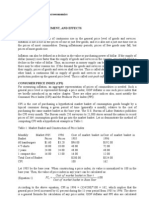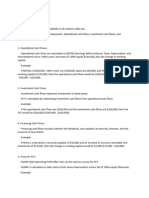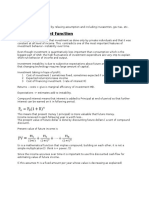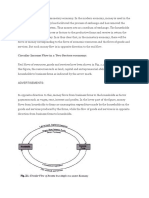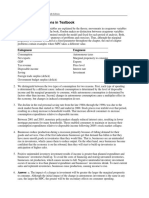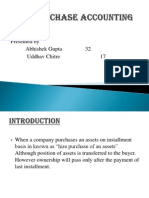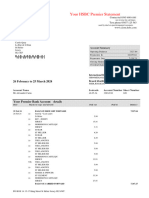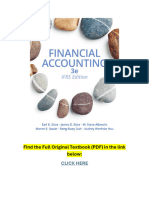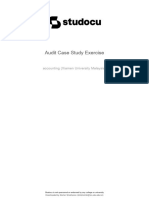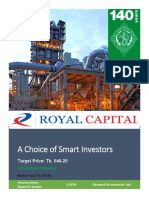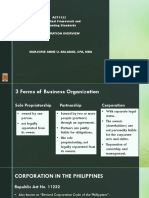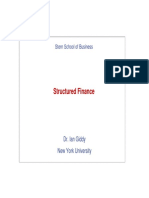A Report On "Corporate Taxation, Inflation and Its Implications On Corporate Financing"
A Report On "Corporate Taxation, Inflation and Its Implications On Corporate Financing"
Uploaded by
vedugptaCopyright:
Available Formats
A Report On "Corporate Taxation, Inflation and Its Implications On Corporate Financing"
A Report On "Corporate Taxation, Inflation and Its Implications On Corporate Financing"
Uploaded by
vedugptaOriginal Description:
Original Title
Copyright
Available Formats
Share this document
Did you find this document useful?
Is this content inappropriate?
Copyright:
Available Formats
A Report On "Corporate Taxation, Inflation and Its Implications On Corporate Financing"
A Report On "Corporate Taxation, Inflation and Its Implications On Corporate Financing"
Uploaded by
vedugptaCopyright:
Available Formats
A report on Corporate Taxation, Inflation and its implications on Corporate Financing
Submitted for internal assessment of Special Study In Finance to Prof. a!een "ego, Faculty for Special Study In Finance, #ulund College of Commerce.
Submitted by Students of T$%#S &'t( Sem) ira* %iyani "oll o. +,-, S(e.(ar /ais0al "oll o. +,1, S(ardd(a Sat(e "oll o. +,,2 inad 3aidya "oll o. +,4-
Concepts
1. Impact of inflation on Corporate Finance
Ans. Same as t(eory 5uestion no. 1
2. Provision of Minimum Alternative Tax (MAT)
Ans. ormally, a company is liable to pay tax on t(e income computed in accordance 0it( t(e pro!isions of t(e Income Tax Act, but t(e profit and loss account of t(e company is prepared as per pro!isions of t(e Companies Act. T(ere 0ere large number of companies 0(o (ad boo. profits as per t(eir profit and loss account but 0ere not paying any tax because income computed as per pro!isions of t(e income tax act 0as eit(er nil or negati!e or insignificant. In suc( case, alt(oug( t(e companies 0ere s(o0ing boo. profits and declaring di!idends to t(e s(are(olders, t(ey 0ere not paying any income tax. T(ese companies are popularly .no0n as Zero Tax companies. In order to bring suc( companies under t(e income tax act net, section 116/A 0as introduced 0.e.f assessment year 177+879. According to t(is section, if t(e taxable income of a company computed under t(is Act, in respect of pre!ious year 177'87+ and on0ards is less t(an ,- : of its boo. profits, t(e total income of suc( company is c(argeable to tax for t(e rele!ant pre!ious year s(all be deemed to an amount e5ual to ,- : of suc( boo. profits.
Theory
uestions!
A) Impact of inflation on Corporate Finance
Ans. Inflation and asset re!aluation Inflation and firm !alue Inflation and financial returns Inflation and inno!ation in t(e financial mar.ets Inflation and financial analysis Inflation and capital budgeting 1. I"F#ATI$" A"% A&&'T (')A#*ATI$" In an inflationary period, t(e boo. !alue of assets, typically reflecting (istorical cost less accumulated depreciation, do not reflect t(eir true !alues. ;ence it may be 0ort(0(ile to consider re!aluation of assets periodically so t(at t(e asset !alues s(o0n in t(e balance s(eet reflect economic reality more accurately. $+,'CTI)'& $F (')A#*ATI$" "e!aluation of asset is underta.en 0it( one or more of t(e follo0ing ob*ecti!es in mind< To attract in!estors by indicating to t(em t(e current !alues of assets. to ma.e depreciation pro!ision 0(ic( 0ill enable t(e firm to meet replacement needs ade5uately. To pro!ide a more reasonable and accurate perspecti!e regarding t(e trut( 0ort( of assets in t(e e!ent of a possible ta.eo!er or merger.
to (elp management in assessing t(e trut( profitability of different di!isions, formulating a more sensible di!idend policy, pricing its products realistically, fixing t(e mac(ine (our rates in a *ob order situation, and determining t(e desirable insurance co!er for t(e assets. to en(ance t(e borro0ing capacity of t(e firm. It may be noted t(at irrespecti!e of t(e ob*ecti!e soug(t by a firm from t(e re!aluation study, an important ad!antage of suc( an exercise is t(at t(e capital asset records of t(e company are streamlined. 2. I"F#ATI$" A"% FI(M )A#*' If t(e actual rate of inflation is e5ual to t(e anticipated rate of inflation, t(e !alue of t(e firm remains more orless unaffected. T(is is so because t(e anticipated rate of inflation is properly embodied in t(e returns expected by t(e supplier of capital, t(e prices expected for t(e products=ser!ices sold by t(e firm, t(e compensation expected by t(e suppliers of !arious inputs, so on and so fort(. >(en t(e actual rate of inflation differs from t(e anticipated rate of inflation, t(e firm !alue is li.ely to c(ange. T(e impact on firm !alue depends on se!eral factors< debtors8creditors position, price8cost responsi!eness, and depreciation and in!entory c(arges. %e-tor.cre/itor position >it( an unsnticipated increase in inflation, t(e borro0er benefits because t(e loan is repaid in c(eaper money t(an originally anticipated. To illustrate, consider a loan 0(ic( carries a 12: nominal rate of interest based on an 9: expected inflation rate and a re5uired 4: real rate of return. If t(e actual inflation rate turns out to be 1-:, rat(er t(an t(e expected 9:, t(e real rate of return 0ould be 2:and not 4:. As a conse5uence, t(e borro0er gains 0(ereas t(e lender loses. An unanticipated decrease in inflation 0ould (a!e t(e opposite conse5uences< t(e borro0er 0ill lose 0(ereas t(e lender 0ill gain. T(e impact of an unanticipated increase in inflation on t(e 0ealt( of a firm 0ill depend on 0(et(er t(e firm is a net creditor or a net debtor. &A firm is a net debtor if t(e opposite is true, i.e., its financial liabilities exceed its financial assets). If a firm is a net creditor, an unanticipated increase in inflation decreases its 0ealt(. ?n t(e ot(er (and, if a firm is a net debtor, an unanticipated 0ould (a!e t(e opposite conse5uences< net creditor 0ill gain 0(ereas a net debtor 0ill lose. Price.cost responsiveness T(e sensiti!ity of prices&of t(e firm@s outputs) and costs &of t(e firm@s inputs li.e ra0 material, utilities, manpo0er, etc.) to unanticipated inflation influences t(e !alue of
t(e firm. If prices and costs !ary proportionally 0it( unanticipated inflation, t(e c(ange in t(e nominal !alue of t(e firm 0ill be suc( t(at t(e real rate of return on capital 0ould remain more or less unc(anged. If t(e prices respond 5uic.ly, 0(ereas costs respond slo0ly, to unanticipated inflation increase, t(e !alue of t(e firm tend to increase. ?n t(e ot(er (and, if costs respond 5uic.ly, but prices respond slo0ly, to anticipated inflation increase, t(e !alue of t(e firm tends to decline. An unanticiapetd decrease in inflation 0ould (a!e t(e opposite effects< 1. t(e firm !alue tends to decrease 0(en prices lead costs, 2. t(e firm !alue tends to increase 0(en costs lead prices. %epreciation an/ inventory char0es Aepreciation c(arges are based on t(e (istorical costs of assets. Auring an inflationary period replacement costs are greater t(an (istorical costs. ;ence, depreciation c(arges, based on (istorical costs, not replacement costs, entails a (ig(er tax burden for t(e firm. T(is tends to detract from t(e !alue of t(e firm. A similar effect obtains 0it( respect to in!entories because in!entory costs are c(arges on t(e basis of original &(istorical) costs and not replacement costs. T(e effect is particularly pronounced 0(en t(e firm uses FIF? system of in!entory accounting. Bnder t(is system, recorded in!entory costs are lo0er t(an replacement costs in an inflationary period. As a result, accounting income is o!erstated. T(is leads to a (ig(er tax burden and a conse5uent diminution in t(e !alue of t(e firm. T(is problem can be significantly mitigated by follo0ing t(e CIF? system of in!entory accounting. Bnder t(is system t(e recorded in!entory costs tend to be fairly close to t(eir replacement costs and (ence t(e additional burden on account of taxes may be !ery marginal. 1. I"F#ATI$" A"% FI"A"CIA# MA(2'T ('T*("& T(e expected return on security 0as defined as t(e rate of discount 0(ic( ma.es t(e present !alue of t(e stream of expected cas( inflo0s e5ual to t(e price of t(e security. Clearly, t(e expected rate of return 0as defined in nominal terms. T(is implies t(at t(e cas( flo0s are expressed in current rupees, at t(e time of receipt and not ad*usted for inflation. In an inflationary period, t(e current rupees at t(e time of receipt 0ill (a!e lesser purc(asing po0er t(an t(e rupees deployed to buy t(e security. As a conse5uence, t(e real rate of return on t(e security 0ill be less t(an its nominal rate of return. For eg. If
t(e nominal rate of return is 16: and t(e inflation rate is 1-: t(e real rate of return 0ill be approximately 6:. 3. I"F#ATI$" A"% I""$)ATI$"& I" T4' FI"A"CIA# MA(2'T&
Inflation reduces t(e purc(asing po0er of money. If t(e rate of inflation is, say, 1-: p.a, t(e purc(asing po0er of money declines by 1-: p.a. In suc( a situation, an income increase of 1-:p.a is re5uired to protect one@s real income. Ci.e0ise, if t(e rate of inflation is 1-:p.a, t(e rate of return on in!estment must be at least 1-: per year to a!oid erosion in real 0ealt(. To earn a positi!e real rate of return in a situation li.e t(is, t(e nominal rate of return must be greater t(an t(e inflation rate, namely 1-:. In order to cope 0it( inflation, employees see. 0age increases related to consumer price index and business firms include escalator clauses in supply contracts. >(at inno!ations=de!elopments (a!e occurred in financial mar.ets in response to inflationD T(e follo0ing (a!e been t(e important inflation8induced inno!ations=de!elopments in financial mar.ets< 1. Flexible interest rates 2. Cenders participation in e5uity ,. Financial futures
5. I"F#ATI$" A"% FI"A"CIA# A"A#6&I&
T(e financial performance of a firm as reflected in con!entionally prepared financial statements &0(ic( are based on (istorical costs) is influenced partly by managerial decisions and partly by external influences, particularly inflation, 0(ic( are beyond t(e control of management. As a result, t(e performance s(o0n by financial statements may cloud t(e economic performance. Illustration< To illustrate t(e distortion caused by inflation consider an example. E$F Co. a retail firm, began business on Aecember ,1, 1777 and (as t(e balance s(eet at t(at time< #ia-ilities G5uity "s.', --,--Assets et Fixed Assets In!entory Cas( "s.2, --,--"s.,, --,--"s.1, --,---
T(e fixed assets, assumed to (a!e a life of 1- years, are depreciated at t(e rate of 1- per cent per year on straig(t line basis. T(e firm follo0s t(e first8in8first8out &FIF?) met(od of in!entory pricing. T(e inflation rate for t(e year, 0(ic( ended on
Aecember ,1, 2--1, 0as 2- per cent H for t(e sa.e of simplicity it may be assumed t(at t(e inflation occurred at t(e beginning of t(e year. T(e sales for t(e year occurred at t(e end of t(e year. T(e firm is not liable to pay any taxes. T(e income statement of t(e firm for t(e first year of its operations I, as reported on (istorical coat basis 0as as follo0s<
Income statement Sales "s.6, --,--Cost of Joods Sold %eginning In!entory "s.,, --,--Purc(ases "s.,, '-,--Gnding in!entory "s. &,,'-,---) "s.,, --,--Aepreciation &2, --,---=1-) "s.2-, --Selling and Administrati!e expenses "s.9-, --et Profit "s.1, --,--It may be noted t(at t(e firm boug(t replenis(ment in!entories at t(e end of t(e first year for "s.,, '-,--- 0(en t(e prices 0ere 2- per cent (ig(er t(an 0(at t(ey 0ere at t(e beginning of t(e year. T(e balance s(eet of t(e firm as on Aecember ,1, 2--1 0as as follo0s< #ia-ilities G5uity Capital "eser!es "s.', --,--et Fixed Assets "s.1, --,--- In!entories Cas( KKKKKKKKKK "s.+, --,--Assets "s.1, --,--"s.,, '-,--"s.1, '-,--KKKKKKKKKKK "s.+, --,---
T(e t0o commonly used profitability ratios 0ere< et profit margin &1, --,---=6, --,---) I 2- per cent "eturn on total assets &1, --,---=', --,---) I 1'.'+ per cent T(ese measures, (o0e!er, o!er8state t(e underlying economic profitability for t0o reasons< 1. Bnder t(e FIF? met(od, in!entories t(at are sold are assumed to (a!e been boug(t at prices pre!ailing 0(en t(e oldest items in t(e in!entories 0ere boug(t. >it( inflation, t(ese prices are less t(an t(eir replacement cost. In t(e case of E$F company, in!entories sold (a!e been !alued at "s.,, --,--- for t(e purpose of accounting, t(oug( t(eir replacement cost at t(e time of sales 0as "s.,, '-,---. ;ence, t(e costing of in!entories as per FIF? met(ods result in understatement of economic costs and o!er8statement of economic profits in an inflationary period. 2. Bnder (istorical cost accounting, depreciation c(arges are based on original cost of t(e fixed assets. >it( inflation, t(e replacement cost of t(ese assets is greater t(an t(e original cost of fixed assets. >it(
inflation, t(e replacement cost of t(ese assets is greater t(an t(e original cost. So, a depreciation c(arge based on original cost understates t(e economic depreciation 0(ic( is based on replacement cost. For E$F Company t(e depreciation c(arge based on original cost is "s.2-,---, 0(ereas t(e economic depreciation is "S.24,--- &1- per cent of t(e replacement cost of "s.2, 4-,---). Bsing t(e replacement cost basis, t(e income statement of E$F Company for t(e year 2--1 is s(o0n belo0< Income &tatement Sales Cost of goods sold Aepreciation &2, 4-,---=1-) Selling and Administrati!e expenses et Profit "s.6, --,--"s.,, '-,--"s.24,--"s.9-,--"s.,',---
T(e profitability ratios based on economic profits, as against profits on a (istorical cost basis, are< et profit margin "eturn on total assets &,',---=6, --,---) I +.2 per cent &,',---=+, --,---) I 6.14 per cent
T(us, 0e find t(at t(e profitability measures based on economic performance are substantially lo0er t(an t(ose based on accounting data. Continuing our example, suppose t(e rate of inflation in 2--2 is nil and t(e income statement of t(e company, on a (istorical basis, is as follo0s< Income &tatement Sales "s.6, --,--Cost of goods sold %eginning in!entory "s.,, '-,--Purc(ases "s.,, '-,--Gnding in!entory "s. &,, '-,---) "s.,, '-,--Aepreciation &2, --,---=1-) "s.2-,--Selling and Administrati!e expenses "s.9-,--et profit "s.4-,--T(us, t(ere is a s(arp decline in t(e accounting profit of E$F Co. from "s.1, --,--&for t(e year 2--1) to "s.4-,--- &for t(e year 2--2). T(is deterioration in profit performance, (o0e!er, is caused primarily by inflation, not managerial inefficiency. To pro!e t(is point, let us loo. at t(e income statement for t(e year 2--2 prepared on replacement cost basis< Income &tatement Sales Cost of goods sold Aepreciation &2, 4-,---=1-) Selling and Administrati!e expenses et profit "s.6, --,--"s.,, '-,--"s.24,--"s.9-,--"s.,',---
From t(e abo!e statement 0e find t(at 0(en t(e replacement cost basis is used t(e profit figure for t(e year 2--2 is t(e same as t(at of 2--1. since t(e sales of bot( t(e years are t(e same, t(e net profit margin ratio for t(e years, too, is t(e same. >(at about t(e return on total assets for t(e year 2--2 on replacement cost basisD To calculate t(is, 0e need t(e 2--1 balance s(eet prepared on replacement cost basis. T(is is s(o0n belo0< #ia-ilities Assets
G5uity capital "s.', --,--et fixed assets "s.2, 1',--"etained earnings "s.,',--In!entories "s.,, '-,--;olding period gains "s.1, --,--Cas( "s.1, '-,--KKKKKKKKKKKKKK KKKKKKKKKKKKKK "s.+, ,',--"s.+, ,',--T0o items in t(e abo!e balance s(eet need some explanation< 1. T(e net fixed asset figure of "s.2, 1',--- is arri!ed at by ad*usting up0ard t(e gross fixed asset !alue of "s.2, 4-,--- &to reflect t(e inflation rate of 2- per cent) and subtracting 1- per cent depreciation from t(ereon. 2. T(e (olding period gain comprises an increase in t(e !alue of fixed assets &"s.4-,---) and in!entory profit &"s.'-,---) from t(e FIF? met(od 88 bot( t(e gains arise due to inflation in 2--1. Ji!en t(e abo!e balance s(eet, t(e return on total assets for 2--2, based on replacement cost data is< ,',---=+, ,',--- I 4.7 per cent. T(us, 0(ile t(e net profit margin for 2--2 is t(e same as for 2--1, t(e return on total assets for 2--2 is lo0er t(an t(at of 2--1. t(is is because t(e denominator, t(e beginning total assets, is larger for 2--2 t(an for 2--1. Implications! T(e foregoing example s(o0s clearly t(at in face of differing rates of inflation, financial ratios based on suc( rates are !itiated. T(e !agaries of inflation may create t(e impression of c(anges in profitability e!en t(oug( t(e underlying economic profitability may remained unc(anged. Inflation may lead to distortions in t(e inter8firm comparisons as 0ell. In an inflationary en!ironment, 0(en (istorical cost data are used, a firm 0it( older assets, ot(er t(ings being e5ual, 0ill s(o0 (ig(er rate of return on assets. T(is (appens because for t(e firm 0it( older assets &1) t(e reported profits are (ig(er as t(e depreciation c(arges are less, and &2) t(e boo. !alue of t(e assets is lo0er. "ecogniLing t(at bot( time8series and cross8section comparisons can be distorted by t(e effects of inflation, t(e financial analyst s(ould exercise caution in analyLing financial statements. It may be ad!isable, particularly in a period of rapidly c(anging inflation rates, to conduct financial analysis on t(e basis of replacement cost data. Suc( an analysis, correcting t(e distortion of inflation, presents a more accurate picture of managerial performance.
7. I"F#ATI$" A"% CAPITA# +*%8'TI"8!
Inflation (as been a persistent feature in t(e Indian economy. ;ence, it s(ould be properly considered in capital in!estment appraisal. In practice, (o0e!er, ad*ustment for inflation is rarely, if e!er, made. T(e use of current price structure is deemed satisfactory and reasoning offered runs as follo0s< Inflation is expected to raise t(e re!enues and costs of t(e pro*ect in a similar fas(ion. ;ence, net re!enues after ad*ustment for inflation 0ould e e5ual to t(e net re!enues in current terms. T(e abo!e argument, (o0e!er, o!erloo.s t(e follo0ing considerations 0(ic( cause distortion< 1. T(e depreciation c(arge is based on (istorical costs and (ence t(e tax benefit arising from depreciation c(arge does not .eep pace 0it( inflation 2. t(e cost of capital used for in!estment appraisal contains a premium for anticipated inflation
+) Impact of inflation on Financial &tatements
Ans. Same as t(eory 5uestion A.5
C) Impact of inflation on Corporate Tax Plannin0
Ans.
/) 'xplain the impact of the follo9in0 factors on Corporate Finance
I. Gxport Incenti!es I. %ac.0ard Area Incenti!es II. #ergers M Ac5uisitions Ans. 'xport Incentives Jo!ernment pro!ides !arious incenti!es for exporting companies, 0(ic( (as t(e impact on t(eir corporate finance in !arious 0ays. T(e incenti!es are in t(e form of duty dra0bac., tax (oliday &7-: exemption), cas( subsidy, import license, easy credit from !arious institutionsN T(e impact of t(ese incenti!es are t(at t(e company (as to pay no or less tax on t(e exported goods 0(ic( ot(er0ise (as to be paid t(us sa!e lot of money. T(e export8oriented company@s also get t(e facility of duty dra0bac., t(us sa!e lot of money. T(e company get import license 0it( ease against t(e export done by t(em. Companies also get cas( subsidies against t(e purc(ase of fixed assets utiliLed for producing goods for t(e purpose of export. T(e company 0ill also get easy credit from !arious institutions against t(e export done by t(e firm. +ac:9ar/ Area Incentives Jo!ernment pro!ides !arious incenti!es for companies &plant) in %ac.0ard Area, 0(ic( (as t(e impact on t(eir corporate finance in !arious 0ays. T(e incenti!es are in t(e form of duty dra0bac., tax (oliday, cas( subsidy, infrastructure facilities at c(eaper rate &electricity, fuel, 0ater, etc), easy credit from !arious institutionsN T(e %ac.0ard Area Company@s get t(e facility of duty dra0bac., t(us sa!e lot of money. Companies also get cas( subsidies against t(e purc(ase of fixed assets utiliLed for producing goods. T(e company 0ill also get easy credit from !arious
institutions for setup of plant in %ac.0ard Area. Plants in %ac.0ard Area get infrastructure facilities at c(eaper rate t(us reduce t(eir manufacturing cost. Mer0ers ; Ac<uisitions Impact of mergers M ac5uisitions on corporate finance are as follo0s< a) Company form after merger (as (ig(er purc(asing ability due to increased capital base. b) ?ne company absorb t(e loss of anot(er company and t(us sa!e t(e tax liability. c) #erged company get t(e edge o!er its competitors in t(e mar.et &national M international).
') Profit ; loss A=C as per Companies Act.
Particulars &ales &8) Cost of Sales 8ross Profit #ess! 'xpenses I. Administrati!e II. Finance III. Selling M Aistribution I3. Aepreciation "et Profit (+oo: Profit) Cess< Transfer to Jeneral "eser!e Amount "s. 1--.-6-.-6-.-1-.-1-.-1-.-1-.-4-.-1>.>> 1-.---.--
"otes 1. Aepreciation as per I=T Act is "s. 22. Calculate %oo. Profit Taxable Income, Tax Payable O ,- : P 2 : surc(arge &including #AT). Ans. %oo. Profit "s. 1-.-%oo. Profit Taxable Income "s. ,.-- &,- : of %oo. Profit) T(erefore, Tax Payable O &,- P 2) : I "s. -.7' &See concept ans0er 2 for explanation)
You might also like
- (Download PDF) Business Analysis and Valuation Ifrs Edition Erik Peek Full Chapter PDFDocument69 pages(Download PDF) Business Analysis and Valuation Ifrs Edition Erik Peek Full Chapter PDFwendhyderpo60100% (15)
- Corporate Restructuring Short Notes PDFDocument31 pagesCorporate Restructuring Short Notes PDFgayathris111100% (2)
- Investment Appraisal Taxation, InflationDocument8 pagesInvestment Appraisal Taxation, InflationJiya RajputNo ratings yet
- (Lecture 3) - Inflation and Capital AllowanceDocument9 pages(Lecture 3) - Inflation and Capital AllowanceAjay Kumar Takiar100% (1)
- FIN621 Solved MCQs Finalterm Mega FileDocument23 pagesFIN621 Solved MCQs Finalterm Mega Filehaider_shah882267No ratings yet
- What Is InflationDocument7 pagesWhat Is InflationSOMOSCONo ratings yet
- CAHAPTER 5 InvestmentDocument15 pagesCAHAPTER 5 Investmentsiddev12344321No ratings yet
- Effects of Inflation and Capital BudgetingDocument2 pagesEffects of Inflation and Capital BudgetingKathlaine Mae ObaNo ratings yet
- Parkinmacro11 1300Document19 pagesParkinmacro11 1300Mr. JahirNo ratings yet
- CH-004 Investment Appraisal – Further Aspects of Discounted Cash FlowsDocument26 pagesCH-004 Investment Appraisal – Further Aspects of Discounted Cash Flowssabinparajuli64No ratings yet
- Parkinmacro11 (28) 1200Document19 pagesParkinmacro11 (28) 1200nikowawa100% (1)
- What Is InflationDocument5 pagesWhat Is InflationJeremiah LuhendeNo ratings yet
- Chapter 29 SolutionsDocument2 pagesChapter 29 SolutionsKlajdPanaritiNo ratings yet
- Lecture One Economic Trade Cycle and Circular Flow of IncomeDocument16 pagesLecture One Economic Trade Cycle and Circular Flow of IncomekellaraydennNo ratings yet
- Department of Banking and Finance: Abdu Gusau Polytechnic Talata Mafara Zamfara StateDocument7 pagesDepartment of Banking and Finance: Abdu Gusau Polytechnic Talata Mafara Zamfara StateSOMOSCONo ratings yet
- Negative Real Interest Equities GenreDocument0 pagesNegative Real Interest Equities Genretkgoon6349No ratings yet
- Minimum Corporate Income Tax: A Bane or A Boon? by Rosalino G. Fontanosa, Cpa, MbaDocument14 pagesMinimum Corporate Income Tax: A Bane or A Boon? by Rosalino G. Fontanosa, Cpa, MbaanggandakonohNo ratings yet
- Quiz #3, Answers: 14.02 Principles of MacroeconomicsDocument10 pagesQuiz #3, Answers: 14.02 Principles of MacroeconomicsEmmanuel MbonaNo ratings yet
- CH 11 HW SolutionsDocument9 pagesCH 11 HW SolutionsAriefka Sari DewiNo ratings yet
- Chapter 6-Price Changes & InflationDocument27 pagesChapter 6-Price Changes & InflationJok eRNo ratings yet
- READING 10 Industry and Company AnalysisDocument26 pagesREADING 10 Industry and Company AnalysisDandyNo ratings yet
- Quiz #3, Answers: 14.02 Principles of MacroeconomicsDocument10 pagesQuiz #3, Answers: 14.02 Principles of MacroeconomicsrohityadavalldNo ratings yet
- Net Profit or Loss For The Period, Prior Period Items and Changes in Accounting PoliciesDocument6 pagesNet Profit or Loss For The Period, Prior Period Items and Changes in Accounting Policiessanyu1208No ratings yet
- Chapter 5 DCF With Inflation and Taxation: SyllabusDocument28 pagesChapter 5 DCF With Inflation and Taxation: SyllabusМөнхзаяаа БаянмөнхNo ratings yet
- 10 MarksqDocument11 pages10 MarksqshivamsyaanNo ratings yet
- Department of Banking and FinanceDocument6 pagesDepartment of Banking and FinanceSOMOSCONo ratings yet
- Notes On Principles of MacroeconomicsDocument5 pagesNotes On Principles of MacroeconomicsSuniel ChhetriNo ratings yet
- Interest: L PinDocument8 pagesInterest: L Pineka putri sri andrianiNo ratings yet
- Inflation and Real Growth Handbook: Army Budget Office APRIL 2002Document38 pagesInflation and Real Growth Handbook: Army Budget Office APRIL 2002Mahima AgrawalNo ratings yet
- Chapter 16 DCF With Inflation and Taxation: 1. ObjectivesDocument7 pagesChapter 16 DCF With Inflation and Taxation: 1. ObjectivesShir Aboks HughesNo ratings yet
- Glossary of Economic TermsDocument10 pagesGlossary of Economic TermsRaj KadamNo ratings yet
- Chapter 6 Economic Growth, The Financial System, and Business Cycles NotesDocument11 pagesChapter 6 Economic Growth, The Financial System, and Business Cycles NotesBeatriz CanchilaNo ratings yet
- Ch3 InflationDocument26 pagesCh3 InflationXà XàNo ratings yet
- Tips InvestingDocument12 pagesTips InvestingIbn Faqir Al ComillaNo ratings yet
- The Stable Growth RateDocument2 pagesThe Stable Growth RateSuuhail RajaniNo ratings yet
- Cyclically-Normalized Real Econ Earnings Classroom Note - 2020 VersionDocument8 pagesCyclically-Normalized Real Econ Earnings Classroom Note - 2020 VersionJeremiah KhongNo ratings yet
- Notes On Principles of Macroeconomics: X Year Base in Basket Market of Cost T Year in Basket Market of Cost PIDocument5 pagesNotes On Principles of Macroeconomics: X Year Base in Basket Market of Cost T Year in Basket Market of Cost PIRamanatharshanan ArasanayagamNo ratings yet
- Lecture Notes: Chapter 10: Investment, Net Exports, and Interest RatesDocument19 pagesLecture Notes: Chapter 10: Investment, Net Exports, and Interest RatesQamarIqbalkhanNo ratings yet
- Keynesian Concept of Multiplier Which States ThatDocument4 pagesKeynesian Concept of Multiplier Which States ThatAnjitha BijithNo ratings yet
- Ratio Analysis: OV ER VIE WDocument40 pagesRatio Analysis: OV ER VIE WSohel BangiNo ratings yet
- Week1 SlideDocument6 pagesWeek1 SlideSelin AkbabaNo ratings yet
- SOLVED UGBS 204-2021 EXAMS QUESTIONSDocument9 pagesSOLVED UGBS 204-2021 EXAMS QUESTIONSalbert.nekuNo ratings yet
- Economic Module 15Document20 pagesEconomic Module 15PatrickNo ratings yet
- FM11 CH 04 Mini CaseDocument6 pagesFM11 CH 04 Mini CaseAmjad Iqbal100% (1)
- Supporting Notes For ProfitDocument7 pagesSupporting Notes For ProfitVrkNo ratings yet
- The Circular Flow of National IncomeDocument12 pagesThe Circular Flow of National IncomePallaviSinhaNo ratings yet
- Financial Statement Analysis of Square PharmaceuticalsDocument15 pagesFinancial Statement Analysis of Square PharmaceuticalsAushru HasanNo ratings yet
- Week 9 SolutionsDocument5 pagesWeek 9 SolutionsAdnan DebsNo ratings yet
- NAME6Document7 pagesNAME6SOMOSCONo ratings yet
- Circular Flow of EconomyDocument19 pagesCircular Flow of EconomyAbhijeet GuptaNo ratings yet
- Economics PaperDocument15 pagesEconomics PaperSamad Ashraf MemonNo ratings yet
- GDP & Its TypesDocument2 pagesGDP & Its TypesArul ManikandanNo ratings yet
- Solution Manual Macroeconomics Robert J Gordon The Answers From The Book On Both The Questions and The Problems Chapter 3Document6 pagesSolution Manual Macroeconomics Robert J Gordon The Answers From The Book On Both The Questions and The Problems Chapter 3Eng Hinji RudgeNo ratings yet
- Possible Answer - Eco (1) ScopeDocument13 pagesPossible Answer - Eco (1) Scopenomusamofokeng8No ratings yet
- Module 3 Economic GrowthDocument9 pagesModule 3 Economic Growthexequielmperez40No ratings yet
- Part - 2 - Dashboard - Inflation and The Financial RatiosDocument4 pagesPart - 2 - Dashboard - Inflation and The Financial RatiosJaquelyn JacquesNo ratings yet
- Circular Flow of IncomeDocument6 pagesCircular Flow of IncomePrithivi RajNo ratings yet
- Net Sales Gross Sales - (Returns and Allowances)Document11 pagesNet Sales Gross Sales - (Returns and Allowances)kanchanagrawal91No ratings yet
- NYJC Inflation H2 Econs NotesDocument6 pagesNYJC Inflation H2 Econs NotesDaniel PngNo ratings yet
- CSNW - zUSS1SJ8P81EptUnw - Macroeconomics Background Notes - Module 1 c2 - v2Document22 pagesCSNW - zUSS1SJ8P81EptUnw - Macroeconomics Background Notes - Module 1 c2 - v2farinNo ratings yet
- Eco202 Exam ReviewDocument5 pagesEco202 Exam Reviewaoi.ishigaki101No ratings yet
- Quantum Strategy II: Winning Strategies of Professional InvestmentFrom EverandQuantum Strategy II: Winning Strategies of Professional InvestmentNo ratings yet
- Swarozgar Credit CardDocument3 pagesSwarozgar Credit CardvedugptaNo ratings yet
- What Are The Associated WithDocument6 pagesWhat Are The Associated WithvedugptaNo ratings yet
- 1 IntroductionDocument8 pages1 IntroductionvedugptaNo ratings yet
- The Foreign Exchange MarketDocument27 pagesThe Foreign Exchange MarketvedugptaNo ratings yet
- On SSFDocument5 pagesOn SSFvedugptaNo ratings yet
- Annexure CDocument1 pageAnnexure CvedugptaNo ratings yet
- Topic 2Document29 pagesTopic 2vedugptaNo ratings yet
- JagrutiDocument14 pagesJagrutivedugptaNo ratings yet
- Presented by Abhishek Gupta 32 Uddhav Chitre 17Document11 pagesPresented by Abhishek Gupta 32 Uddhav Chitre 17vedugptaNo ratings yet
- AdvertismentDocument10 pagesAdvertismentvedugptaNo ratings yet
- 30 - MACRS DepreciationDocument4 pages30 - MACRS Depreciationidriwal mayusdaNo ratings yet
- Elgi Annual Report 2023 24Document346 pagesElgi Annual Report 2023 24saranyaNo ratings yet
- Capital Expenditures (CapEx)Document9 pagesCapital Expenditures (CapEx)JonalleeNo ratings yet
- Quiz 5 - Capital Market Theory and Asset Pricing Models - Attempt ReviewDocument3 pagesQuiz 5 - Capital Market Theory and Asset Pricing Models - Attempt ReviewDivya chandNo ratings yet
- Atif Noor - Resume - 22092015Document4 pagesAtif Noor - Resume - 22092015Muhammad Atif NoorNo ratings yet
- Income Tax Question BankDocument18 pagesIncome Tax Question Bankshemanthkumar438No ratings yet
- Chapter 3 - Financial Reporting and The Balance SheetDocument49 pagesChapter 3 - Financial Reporting and The Balance SheetDan RyanNo ratings yet
- Poa ReviewerDocument4 pagesPoa Reviewerdevora aveNo ratings yet
- CH 11Document27 pagesCH 11adhaya568No ratings yet
- DT 2 New Question PaperDocument11 pagesDT 2 New Question Paperneha manglaniNo ratings yet
- Financial Statement AnalysisDocument53 pagesFinancial Statement Analysisremon4hrNo ratings yet
- Introduction To AccountingDocument17 pagesIntroduction To AccountingSiddeq HalimNo ratings yet
- Capital Budgeting For Project AppraisalDocument117 pagesCapital Budgeting For Project Appraisalmdasraful466 jnuNo ratings yet
- Revision Test Paper CAP III June 2017Document265 pagesRevision Test Paper CAP III June 2017AANo ratings yet
- 2024 03 25 - StatementDocument9 pages2024 03 25 - Statementngxjcbp8jdNo ratings yet
- Principles of Financial Accounting IFRS Edition 3th Edition TEXTBOOKDocument11 pagesPrinciples of Financial Accounting IFRS Edition 3th Edition TEXTBOOKhanica7937No ratings yet
- Audit Case Study ExerciseDocument25 pagesAudit Case Study ExerciseAlisher ShokhanovNo ratings yet
- Introduction To Capital BudgetingDocument20 pagesIntroduction To Capital BudgetingMary R. R. PanesNo ratings yet
- Business Valuation Heidelberg Cement BangladeshDocument18 pagesBusiness Valuation Heidelberg Cement BangladeshRajib AhmedNo ratings yet
- Beneish Model Score (SIDO) 123Document12 pagesBeneish Model Score (SIDO) 123Ananda LukmanNo ratings yet
- Important Questions For Class 11 Accountancy Chapter 10 - Financial Statements IIDocument16 pagesImportant Questions For Class 11 Accountancy Chapter 10 - Financial Statements IIABHISHEK SINGHNo ratings yet
- s16 f7 QDocument17 pagess16 f7 QJean LeongNo ratings yet
- ACT1122 - CFAS - Corporation OverviewDocument28 pagesACT1122 - CFAS - Corporation OverviewAndrea Mae Anne AgasangNo ratings yet
- Review Test Submission - Lecture 5 - Online Assignment - ..Document5 pagesReview Test Submission - Lecture 5 - Online Assignment - ..RishabhNo ratings yet
- Structured FinanceDocument87 pagesStructured FinanceJuan Manuel FigueroaNo ratings yet
- Cma Inter 1 Marathon Part 1 December 2023Document63 pagesCma Inter 1 Marathon Part 1 December 2023Ram krushna PandaNo ratings yet
- Prepared by Arpit & ShikhaDocument24 pagesPrepared by Arpit & ShikhahitzassudaniNo ratings yet
- Axis Small Cap FundDocument6 pagesAxis Small Cap FundAlok .kNo ratings yet
